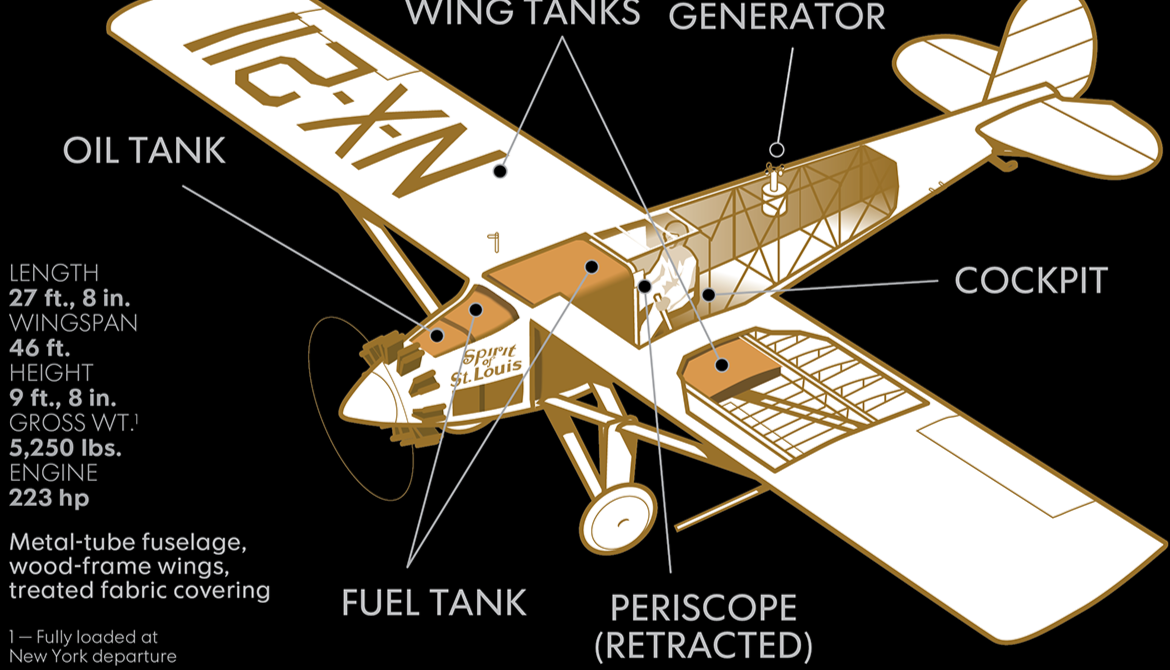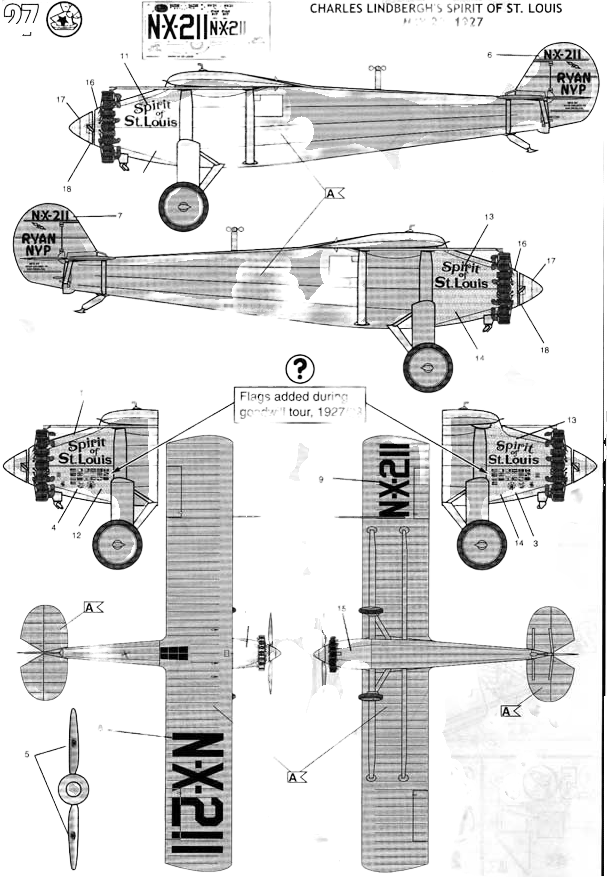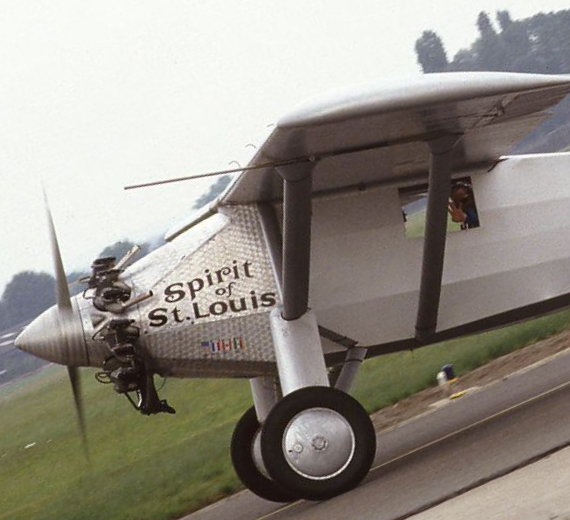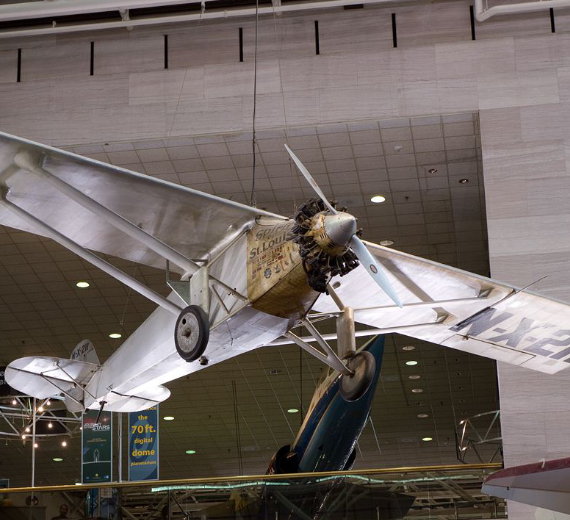Ryan Aeronauticall
Spirit of St. Louis (NYP)
 |
|
| The Spirit at the National Air and Space Museum | |
| Role | Long-range aircraft [for record attempt] |
|---|---|
| Manufacturer | Ryan Airlines |
| Designer | Donald A. Hall |
| First flight | April 28, 1927 |
| Retired | April 30, 1928 |
| Produced | 1927 |
| Number built | 1 (not including later replicas and reproductions) |
| Developed from | Ryan M-2 |
| Career | |
| Registration | N-X-211 |
| Owners and operators | Charles Lindbergh |
| Flights | 174 |
| Total hours | 489 hours, 28 minutes |
| Preserved at | National Air and Space Museum |
.
History Ryan Aeronautical company.
Spirit of St. Louis (formally the Ryan NYP
First flight April 28, 1927
Retired April 30, 1928
Produced 1927

The Spirit of St. Louis (formally the Ryan NYP, registration: N-X-211) is the custom-built, single-engine, single-seat, high-wing monoplane that was flown by Charles Lindbergh on May 20–21, 1927, on the first solo nonstop transatlantic flight from Long Island, New York, to Paris, France, for which Lindbergh won the $25,000 Orteig Prize.
Lindbergh believed that multiple engines resulted in a greater risk of failure while a single-engine design would give him greater range. To increase fuel efficiency, the Spirit of St. Louis was also one of the most advanced and aerodynamically streamlined designs of its era.
Lindbergh believed that a flight made in a single-seat monoplane designed around the dependable Wright J-5 Whirlwind radial engine provided the best chance of success. The Ryan NYP had a total fuel capacity of 450 U.S. gallons (1,700 L; 370 imp gal) or 2,710 pounds (1,230 kg) of gasoline, which was necessary in order to have the range to make the anticipated flight non-stop. The fuel was stored in five fuel tanks, a forward tank – 88 U.S. gal (330 L; 73 imp gal), the main – 209 U.S. gal (790 L; 174 imp gal), and three wing tanks – total of 153 U.S. gal (580 L; 127 imp gal). Lindbergh modified the design of the plane's "trombone struts" attached to the landing gear to provide a wider wheelbase in order to accommodate the weight of the fuel.
Development

Lindbergh and the Spirit of St. Louis at Roosevelt Field, with perlée engine-turned finishing on the nose panels. Lindbergh believed that multiple engines resulted in a greater risk of failure while a single-engine design would give him greater range. To increase fuel efficiency, the Spirit of St. Louis was also one of the most advanced and aerodynamically streamlined designs of its era.
Lindbergh believed that a flight made in a single-seat monoplane designed around the dependable Wright J-5 Whirlwind radial engine provided the best chance of success. The Ryan NYP had a total fuel capacity of 450 U.S. gallons (1,700 L; 370 imp gal) or 2,710 pounds (1,230 kg) of gasoline, which was necessary in order to have the range to make the anticipated flight non-stop. The fuel was stored in five fuel tanks, a forward tank – 88 U.S. gal (330 L; 73 imp gal), the main – 209 U.S. gal (790 L; 174 imp gal), and three wing tanks – total of 153 U.S. gal (580 L; 127 imp gal).[5] Lindbergh modified the design of the plane's "trombone struts" attached to the landing gear to provide a wider wheelbase in order to accommodate the weight of the fuelSpirit of St. Louis replica at the EAA Aviation Museum
0
KmCeiling
0
KmCombat RANGE
0
Km/hAircraft Speed
0
Max Crew
Photo Gallery
Ryan Aeronautical Company
Spirit of St. Louis (formally the Ryan NYP
First flight April 28, 1927
Retired April 30, 1928
Produced 1927


Ryan Aeronautical Company
Spirit of St. Louis (formally the Ryan NYP
General Info
-
-
- Crew: 1
- Length: 27 ft 7 in (8.41 m)
- Wingspan: 46 ft (14 m)
- Height: 9 ft 10 in (3.00 m)
- Wing area: 320 sq ft (30 m2)
-
Powerplant
-
-
- Empty weight: 2,150 lb (975 kg)
- Gross weight: 2,888 lb (1,310 kg)
- Max takeoff weight: (2,329 kg)
- Fuel capacity: 1,703 L)
- Powerplant: 1 × Wright J-5C Whirlwind 9-cylinder air-cooled radial piston engine, 223 hp (166 kW)
- Propellers: 2-bladed Standard Steel fixed pitch metal propeller
-
Performance
- Maximum speed: (214 km/h,
- Cruise speed: 100–110 mph (160–180 km/h, 87–96 kn)
- Range: 4,100 mi (6,600 km,
- Service ceiling: (5,000 m)
- Wing loading: 16 lb/sq ft
Links to Youtube & Others
The P-47 proved to be a formidable fighter-bomber due to its good armament, heavy bomb load, and ability to survive enemy fire. The P-47's survivability was due in part to its radial piston engine, which unlike comparable liquid-cooled engines, had a high tolerance for damage.
Spirit of St. Louis (formally the Ryan NYP)
Other positive attributes included the P-47's ruggedness; its radial piston engine had a high tolerance for damage compared to liquid-cooled engines,
Youtube Link
In the Pacific, Colonel Neel E. Kearby of the Fifth Air Force claimed 22 Japanese aircraft and was awarded the Medal of Honor














